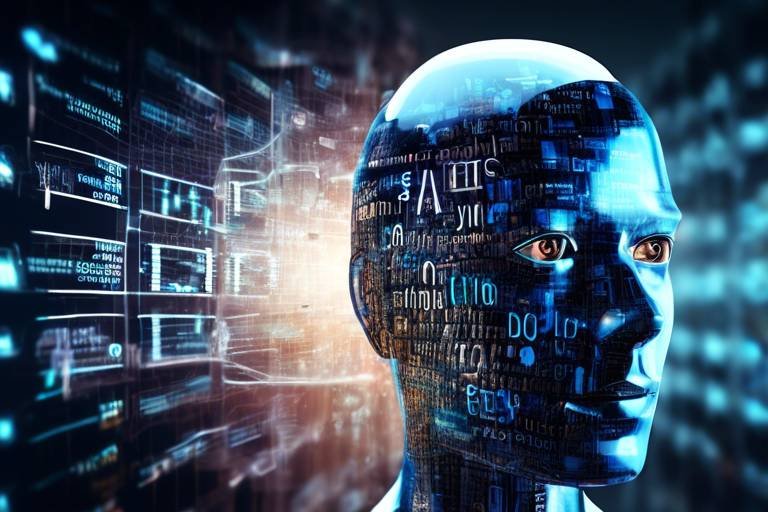The Future of Bioinformatics in Healthcare
Welcome to the exciting world of bioinformatics, where the fusion of biology and technology is reshaping the landscape of healthcare! Imagine a realm where data-driven decisions can lead to better patient outcomes, where research is streamlined, and where personalized medicine is not just a dream but a reality. In this era of rapid advancements, bioinformatics stands at the forefront, ready to revolutionize how we approach health and disease management.
As we delve into this transformative field, it’s essential to recognize the pivotal role it plays in enhancing patient care. With the explosion of big data in healthcare, bioinformatics harnesses vast amounts of genomic and clinical information to identify patterns and insights that were previously hidden. This data-driven approach not only aids in diagnosing diseases more accurately but also tailors treatment plans to fit the unique genetic makeup of each individual.
Furthermore, the integration of bioinformatics into everyday healthcare practices promises to streamline research initiatives. By analyzing complex datasets, researchers can uncover new therapeutic targets and develop innovative treatments at an unprecedented pace. This means that the future of medicine is not just about treating symptoms but understanding the underlying genetic factors that contribute to various health conditions.
But what does this mean for personalized medicine? Well, it means that the days of one-size-fits-all treatments are numbered. Instead, we are entering an era where healthcare providers can create tailored treatment plans based on an individual’s genetic profile. This bespoke approach not only enhances the efficacy of treatments but also minimizes the risk of adverse effects, making healthcare safer and more effective.
In the following sections, we will explore the intricacies of bioinformatics, from the role of big data and advancements in genomic sequencing to its applications in personalized medicine. We will also address the challenges and ethical considerations that come with this powerful technology. So, buckle up as we embark on this journey into the future of bioinformatics in healthcare!
- What is bioinformatics? Bioinformatics is the application of computer technology to manage biological information, particularly in the fields of genomics and molecular biology.
- How does bioinformatics enhance patient care? By analyzing vast datasets, bioinformatics helps identify patterns and insights that can lead to more accurate diagnoses and personalized treatment plans.
- What are the challenges associated with bioinformatics? Challenges include data privacy concerns, ethical implications of genetic testing, and the need for standardization in data interpretation.

The Role of Big Data in Bioinformatics
In today’s digital age, big data has emerged as a game changer in the field of bioinformatics. With the ability to collect and analyze vast amounts of genomic and clinical data, bioinformatics harnesses the power of big data analytics to uncover patterns that can lead to better healthcare solutions. Imagine having a treasure trove of information at your fingertips—this is what big data offers to researchers and healthcare professionals alike. By analyzing this data, we can identify trends, correlations, and insights that were previously hidden, paving the way for innovations in patient care.
The integration of big data into bioinformatics allows for a more comprehensive understanding of complex biological systems. For example, researchers can analyze genetic information alongside clinical data to gain insights into how specific genetic variations influence disease outcomes. This not only enhances our understanding of diseases but also helps in developing targeted therapies that are more effective for individual patients. The synergy between big data and bioinformatics is like finding the right pieces of a puzzle that, when assembled, reveal a clearer picture of health and disease.
To illustrate the impact of big data in bioinformatics, consider the following key areas:
- Data Integration: Big data enables the amalgamation of diverse datasets, including genomic sequences, clinical records, and patient demographics, allowing for a holistic view of patient health.
- Predictive Modeling: By employing machine learning algorithms on large datasets, bioinformatics can predict disease susceptibility and treatment responses, making personalized medicine a reality.
- Real-Time Analytics: The ability to analyze data in real time allows healthcare providers to make swift decisions, improving patient outcomes and operational efficiency.
However, the utilization of big data in bioinformatics does not come without its challenges. Data privacy is a significant concern, as the sensitive nature of genetic information demands stringent protections. Moreover, the sheer volume of data can lead to difficulties in data management and interpretation. It’s essential for healthcare institutions to establish robust frameworks for data governance and ethical guidelines to navigate these challenges effectively.
In summary, the role of big data in bioinformatics is transformative, offering unprecedented opportunities to enhance patient care and advance medical research. As we continue to harness the power of big data, we move closer to a future where healthcare is not just reactive but proactive, tailored to the unique needs of each individual. The journey is just beginning, and the potential is limitless.

Advancements in Genomic Sequencing
Recent advancements in genomic sequencing technologies are not just a step forward; they are a giant leap into the future of healthcare. Imagine being able to decode the very blueprint of life with unprecedented speed and accuracy. This is exactly what modern genomic sequencing offers. With innovations like Next-Generation Sequencing (NGS), researchers can now analyze entire genomes in a fraction of the time it once took, and at a significantly reduced cost. This is crucial for the development of personalized medicine, where treatments are tailored to the individual’s genetic makeup.
One of the most exciting aspects of these advancements is the ability to conduct high-throughput sequencing. This means that instead of sequencing one genome at a time, scientists can sequence thousands simultaneously. As a result, we are no longer limited to studying a handful of genes; we can explore entire genomes to identify the genetic variations that contribute to complex diseases. This capability opens up a world of possibilities for understanding conditions like cancer, diabetes, and heart disease, which are influenced by numerous genetic factors.
Moreover, the decreasing costs of sequencing technologies have democratized access to genomic data. Just a decade ago, sequencing a human genome could cost upwards of $100,000. Today, that price has plummeted to less than $1,000, making it feasible for healthcare institutions of all sizes to integrate genomic data into their patient care practices. This affordability means that more patients can benefit from genetic testing, leading to better diagnostics and more effective treatments.
In addition to cost reductions, the integration of genomic sequencing with clinical data is enhancing its utility in healthcare. By merging genomic data with electronic health records (EHRs), healthcare providers can access a comprehensive view of a patient’s health. This integration allows for more informed decision-making based on a patient’s genetic predispositions, lifestyle, and medical history. For instance, if a patient has a family history of a particular genetic disorder, their healthcare provider can proactively monitor for early signs of that condition, potentially leading to earlier interventions and better outcomes.
Finally, the application of bioinformatics in rare disease research is another remarkable advancement. Rare diseases often go undiagnosed for years due to their complexity and the lack of available information. However, with the power of genomic sequencing, researchers can identify genetic mutations that may be responsible for these conditions. This not only aids in diagnosis but also paves the way for targeted therapies that can dramatically improve the quality of life for patients who previously had no options. As we continue to harness the power of genomic sequencing, the future of healthcare looks brighter than ever.
- What is Next-Generation Sequencing? - NGS is a modern sequencing technology that allows for the rapid sequencing of large amounts of DNA, enabling comprehensive genomic analysis.
- How has the cost of genomic sequencing changed over the years? - The cost of sequencing a human genome has decreased significantly, from over $100,000 to under $1,000, making it accessible to more patients.
- Why is genomic sequencing important for rare diseases? - Genomic sequencing helps identify genetic mutations associated with rare diseases, leading to improved diagnostics and potential treatment options.

Next-Generation Sequencing Technologies
Next-generation sequencing (NGS) technologies have truly revolutionized the field of genomics, opening up new avenues for research and clinical applications that were once thought to be the realm of science fiction. Imagine having the ability to sequence an entire genome in a matter of hours instead of weeks, at a fraction of the cost! This incredible leap forward not only accelerates the pace of discovery but also enhances our understanding of complex diseases and their genetic underpinnings.
At the heart of NGS lies the capacity for high-throughput sequencing, which means that multiple DNA strands can be analyzed simultaneously. This capability is akin to having a powerful microscope that allows scientists to observe countless cells all at once, rather than one at a time. As a result, researchers can now explore genetic variations across large populations, leading to insights that were previously unattainable.
One of the most significant impacts of NGS is its role in personalized medicine. By providing a detailed map of an individual's genetic makeup, healthcare providers can tailor treatment plans to fit the unique needs of each patient. For instance, if a patient is diagnosed with cancer, NGS can help identify specific mutations within their tumor DNA, enabling doctors to select targeted therapies that are more likely to be effective. This approach not only improves outcomes but also minimizes the risk of adverse effects, making treatment safer and more efficient.
Furthermore, the cost of sequencing has plummeted over the years, making it accessible to a broader range of healthcare institutions. To illustrate this point, consider the following table that highlights the dramatic decrease in sequencing costs over the past decade:
| Year | Cost of Whole Genome Sequencing |
|---|---|
| 2009 | $10,000,000 |
| 2015 | $1,500 |
| 2023 | $600 |
This reduction in cost has democratized access to genomic data, allowing smaller clinics and research labs to harness the power of bioinformatics for patient care and groundbreaking research initiatives. As a result, we are witnessing an explosion of discoveries in fields such as oncology, rare diseases, and infectious diseases.
In summary, next-generation sequencing technologies are not just a trend; they represent a paradigm shift in how we approach genomics and healthcare. With their ability to provide rapid, cost-effective, and comprehensive genetic analysis, NGS is paving the way for a future where personalized medicine becomes the norm rather than the exception. As we continue to explore the vast potential of these technologies, the possibilities for improving patient outcomes and advancing scientific knowledge are truly limitless.
- What is next-generation sequencing? NGS is a modern DNA sequencing technology that allows for the rapid and cost-effective sequencing of entire genomes.
- How does NGS impact personalized medicine? NGS enables healthcare providers to create tailored treatment plans based on an individual's genetic information, improving treatment efficacy and reducing side effects.
- What are the applications of NGS? NGS is used in various fields, including cancer research, rare disease diagnosis, and infectious disease detection, among others.
- Is NGS expensive? The cost of NGS has significantly decreased over the years, making it accessible to more healthcare institutions.

Cost Reduction in Sequencing
In recent years, the landscape of genomic sequencing has undergone a remarkable transformation, primarily driven by cost reduction in sequencing technologies. This evolution is akin to the way smartphones revolutionized communication—once a luxury, now an everyday necessity. The plummeting costs associated with sequencing have made it more accessible than ever, paving the way for widespread adoption across healthcare institutions. Just a decade ago, sequencing a human genome could cost upwards of $100,000. Today, that price has dropped to less than $1,000, a staggering reduction that has democratized access to genomic data.
This significant decrease in cost has several implications for the healthcare sector. First and foremost, it allows for the integration of genomic data into routine clinical practice. Imagine a world where every patient’s genetic makeup is readily available to their healthcare provider, enabling personalized treatment plans tailored specifically to their genetic profile. This is not just a futuristic dream; it’s a reality that is becoming increasingly achievable thanks to affordable sequencing.
Furthermore, the affordability of genomic sequencing has opened doors to extensive research opportunities. Researchers can now conduct large-scale studies that were previously financially unfeasible. For instance, institutions can explore large cohorts of patients with similar genetic traits, leading to breakthroughs in understanding complex diseases. This is particularly important in the realm of rare diseases, where identifying genetic mutations can lead to improved diagnostics and potential treatment options.
To illustrate the impact of cost reduction in sequencing, consider the following table:
| Year | Cost of Sequencing a Human Genome | Major Developments |
|---|---|---|
| 2001 | $100,000,000 | Human Genome Project completion |
| 2010 | $10,000 | Introduction of next-generation sequencing |
| 2023 | $1,000 | Widespread clinical application and research |
As we look to the future, the implications of these advancements are profound. More healthcare institutions can now utilize bioinformatics to enhance patient care and research initiatives. This means that patients who might have been overlooked due to the rarity of their conditions now have a fighting chance, as genomic sequencing becomes a standard part of their healthcare journey. It’s a game-changer, and we are just beginning to scratch the surface of what’s possible.
In conclusion, the cost reduction in genomic sequencing is not merely a technical achievement; it is a fundamental shift that has the potential to reshape the entire healthcare landscape. With more affordable access to genomic data, we are moving towards a future where personalized medicine is the norm, and every patient receives care that is precisely tailored to their unique genetic makeup.
- What is bioinformatics? Bioinformatics is the intersection of biology and data science, utilizing computational tools to analyze and interpret biological data, particularly genomic information.
- How has genomic sequencing changed healthcare? Genomic sequencing has enabled personalized medicine, allowing treatments to be tailored to individual genetic profiles, improving efficacy and reducing adverse effects.
- What are the ethical concerns surrounding bioinformatics? Key concerns include data privacy, informed consent for genetic testing, and the implications of genetic information on insurance and employment.
- What is pharmacogenomics? Pharmacogenomics is a branch of bioinformatics that studies how genes affect individual responses to medications, facilitating personalized drug therapies.

Applications in Rare Disease Research
In the realm of healthcare, rare diseases often pose a significant challenge due to their low prevalence and the complexity involved in diagnosing and treating them. However, bioinformatics is emerging as a beacon of hope in this field. By leveraging advanced genomic sequencing technologies, researchers can unravel the genetic underpinnings of these elusive conditions. The integration of genomic data into bioinformatics platforms allows for the identification of specific genetic mutations that are responsible for a variety of rare diseases. This not only aids in accurate diagnostics but also opens the door to potential therapeutic interventions that were previously unattainable.
One of the most compelling aspects of bioinformatics in rare disease research is its ability to analyze vast datasets to identify patterns and correlations that might otherwise go unnoticed. For instance, through the use of next-generation sequencing (NGS), researchers can sequence the genomes of patients with rare diseases and compare them to healthy individuals. This comparative analysis can highlight unique genetic variants associated with the disease, leading to groundbreaking discoveries. In fact, studies have shown that utilizing bioinformatics tools can accelerate the identification of disease-causing mutations by up to 50% compared to traditional methods.
Moreover, bioinformatics platforms facilitate collaboration among researchers worldwide, creating a rich tapestry of shared knowledge. This global network is crucial for rare disease research, as it allows scientists to pool their findings, share genetic data, and develop a more comprehensive understanding of these conditions. For instance, databases such as the Online Mendelian Inheritance in Man (OMIM) and the Genetic and Rare Diseases Information Center (GARD) serve as invaluable resources, providing a centralized repository of genetic information that can be accessed by researchers and healthcare professionals alike.
Furthermore, bioinformatics enables the development of targeted therapies tailored to the specific genetic profiles of patients with rare diseases. By understanding the molecular mechanisms behind these conditions, researchers can design drugs that target the root causes rather than merely alleviating symptoms. This approach not only enhances treatment efficacy but also minimizes the risk of adverse effects, ultimately improving the quality of life for patients.
In summary, the applications of bioinformatics in rare disease research are vast and transformative. From accelerating the discovery of genetic mutations to fostering collaboration among researchers, bioinformatics is reshaping the landscape of how we approach rare diseases. As we continue to harness the power of data and technology, the future looks promising for those affected by these challenging conditions.
- What is bioinformatics? Bioinformatics is an interdisciplinary field that combines biology, computer science, and information technology to analyze and interpret biological data, especially genomic data.
- How does bioinformatics help in rare disease research? Bioinformatics helps identify genetic mutations associated with rare diseases, aids in accurate diagnostics, and facilitates the development of targeted therapies.
- What role does next-generation sequencing play in bioinformatics? Next-generation sequencing allows for rapid and cost-effective sequencing of genomes, enabling comprehensive analysis of genetic information.
- Are there ethical concerns related to bioinformatics? Yes, ethical concerns include data privacy, consent for genetic testing, and implications of genetic information on individuals and families.

Integration with Clinical Data
In today's healthcare landscape, the integration of genomic data with clinical data is not just a luxury; it’s becoming a necessity. Imagine a world where a doctor can look at a patient's entire health history, including their genetic information, all in one glance. This is the promise of bioinformatics when it merges seamlessly with electronic health records (EHRs). By combining these two data sources, healthcare providers can create a more comprehensive profile of their patients, which ultimately leads to better-informed treatment decisions.
One of the most significant advantages of this integration is the ability to identify genetic predispositions to certain diseases. For instance, if a patient has a family history of breast cancer, their genomic data can reveal specific mutations that may increase their risk. Armed with this information, healthcare providers can offer tailored screening protocols and preventive measures, potentially catching diseases earlier than ever before. This proactive approach not only enhances patient outcomes but also reduces healthcare costs in the long run.
Moreover, the integration facilitates a more nuanced understanding of how patients respond to various treatments. With access to both genomic and clinical data, doctors can analyze patterns and make predictions about which therapies are likely to be most effective. This is especially crucial in fields like oncology, where treatments can be highly personalized. For example, a patient with a specific genetic marker might respond exceptionally well to a particular drug, while another with a different genetic background might not. By having this data at their fingertips, healthcare providers can avoid the costly trial-and-error approach that has plagued medicine for decades.
However, the journey towards successful integration is not without its challenges. Data privacy is a significant concern, as sensitive genetic information must be protected from unauthorized access. Additionally, there is a pressing need for standardized systems that ensure data is accurately interpreted and shared across different platforms. To tackle these challenges, stakeholders in the healthcare sector must collaborate to develop robust policies and technologies that safeguard patient information while promoting the sharing of valuable data.
In summary, the integration of genomic data with clinical data is a game-changer for healthcare. It not only enhances the precision of medical decisions but also empowers patients with knowledge about their health. As we continue to navigate this data-driven world, it’s essential that we embrace these advancements while addressing the ethical and practical challenges that come with them.
- What is bioinformatics? Bioinformatics is the application of computer technology to manage and analyze biological data, particularly in genomics and molecular biology.
- How does genomic data integration benefit patient care? It allows healthcare providers to make more informed decisions by understanding a patient's genetic predispositions and tailoring treatments accordingly.
- What are the challenges of integrating genomic data with clinical data? Key challenges include data privacy concerns, the need for standardization, and ensuring accurate interpretation of the data.
- What role does predictive analytics play in bioinformatics? Predictive analytics helps forecast patient responses to treatments by analyzing historical data, enabling more personalized healthcare strategies.

Personalized Medicine and Bioinformatics
Bioinformatics is at the forefront of the personalized medicine revolution, transforming the way we approach healthcare. Imagine a world where your treatment plan is tailor-made just for you, based on your unique genetic makeup. This is not science fiction; it's becoming a reality, thanks to the incredible advancements in bioinformatics. By analyzing an individual's genetic information, healthcare providers can create customized treatment plans that not only improve the effectiveness of therapies but also minimize the risk of adverse side effects. It’s like having a bespoke suit tailored to fit you perfectly, rather than wearing something off the rack that may not suit your style or needs.
One of the key areas where bioinformatics shines is in pharmacogenomics. This fascinating branch focuses on understanding how our genes influence our responses to medications. For instance, some people may metabolize a drug quickly, while others may do so slowly, leading to different outcomes. By leveraging pharmacogenomics, doctors can prescribe medications that are more likely to work for you, reducing the trial-and-error approach that often characterizes traditional prescribing methods. This not only enhances patient safety but also boosts the chances of successful treatment.
Moreover, the integration of predictive analytics in bioinformatics takes personalized medicine a step further. By utilizing historical data, healthcare providers can forecast how a patient is likely to respond to specific treatments. This predictive capability allows for more informed decision-making, ensuring that patients receive the most effective therapies based on their unique genetic and clinical profiles. It’s like having a crystal ball that helps doctors see the potential outcomes of various treatment options, thereby guiding them toward the best possible choice.
However, as we embrace the benefits of personalized medicine through bioinformatics, it's crucial to acknowledge the challenges that come with it. For instance, the interpretation of genetic data can be complex, and not all healthcare providers may be equipped to handle it effectively. Additionally, there are ethical considerations surrounding genetic testing, such as privacy concerns and the potential for discrimination based on genetic information. As we navigate this exciting frontier, it’s essential to establish robust guidelines and support systems to ensure that the benefits of personalized medicine are accessible to all, without compromising individual rights.
In conclusion, the synergy between bioinformatics and personalized medicine is paving the way for a future where healthcare is more effective, safer, and tailored to the individual. As we continue to explore the depths of our genetic code, we stand on the brink of a healthcare revolution that promises to enhance patient outcomes like never before.
- What is personalized medicine? Personalized medicine is an approach to healthcare that tailors treatment plans to individual patients based on their genetic makeup and other factors.
- How does bioinformatics contribute to personalized medicine? Bioinformatics analyzes genetic data to help healthcare providers create customized treatment plans that improve efficacy and reduce side effects.
- What is pharmacogenomics? Pharmacogenomics is the study of how genes affect individual responses to medications, enabling personalized drug therapies.
- What are the challenges of personalized medicine? Challenges include data privacy concerns, ethical implications of genetic testing, and the complexity of interpreting genetic data.

Pharmacogenomics
Pharmacogenomics is a fascinating field that sits at the intersection of genetics and pharmacology. It examines how our unique genetic makeup influences the way we respond to medications. Imagine a world where your doctor can prescribe a medication that is tailored specifically to your genetic profile, minimizing side effects and maximizing effectiveness. This is the promise of pharmacogenomics, and it’s becoming a reality thanks to advancements in bioinformatics.
At its core, pharmacogenomics aims to answer a critical question: why do some patients respond well to a particular drug while others experience adverse reactions or no benefit at all? The answer often lies in our genes. By analyzing genetic variations, healthcare providers can predict how a patient will metabolize a drug, which can significantly impact treatment outcomes.
For instance, certain genetic markers can indicate whether a patient is likely to experience severe side effects from a medication or if they will need a higher or lower dose to achieve the desired effect. This tailored approach not only enhances the effectiveness of treatments but also reduces the trial-and-error process that many patients currently face when starting a new medication.
To illustrate the impact of pharmacogenomics, consider the following table, which highlights some common medications and their associated genetic factors:
| Medication | Genetic Factor | Impact |
|---|---|---|
| Warfarin | CYP2C9, VKORC1 | Dosing adjustments based on genetic variations to prevent bleeding complications. |
| Clopidogrel | CYP2C19 | Increased risk of cardiovascular events in poor metabolizers. |
| Abacavir | HLA-B*5701 | Severe hypersensitivity reactions in carriers of this allele. |
As we delve deeper into the realm of pharmacogenomics, we discover its potential to revolutionize how we approach drug therapy. By leveraging bioinformatics tools, researchers can analyze vast datasets that include genetic information alongside clinical outcomes. This integration of data allows for more precise predictions about which medications will work best for individual patients, thereby enhancing the overall quality of care.
However, while the benefits of pharmacogenomics are clear, several challenges remain. One significant hurdle is the need for comprehensive databases that can aggregate genetic information and clinical outcomes across diverse populations. Moreover, educating healthcare providers about the implications of pharmacogenomic testing is crucial to ensure its successful implementation in clinical practice.
In conclusion, pharmacogenomics is paving the way for a new era of personalized medicine. By understanding the genetic factors that influence drug responses, we can move beyond the one-size-fits-all approach to treatment. As this field continues to evolve, the hope is that patients will receive more effective, safer medications tailored specifically to their genetic profiles.
- What is pharmacogenomics? Pharmacogenomics is the study of how genes affect a person's response to drugs, aiming to tailor medication based on individual genetic profiles.
- How does pharmacogenomics improve patient care? By providing personalized treatment plans, pharmacogenomics can enhance drug efficacy and minimize adverse effects, leading to better patient outcomes.
- Are there any risks associated with pharmacogenomic testing? While generally safe, there may be concerns about privacy, data security, and the potential for genetic discrimination.
- How can I get pharmacogenomic testing? Pharmacogenomic testing is typically ordered by healthcare providers, often through blood or saliva samples, and can be integrated into routine medical care.

Predictive Analytics in Treatment
Predictive analytics in treatment is a game changer in the healthcare landscape, acting like a crystal ball that helps healthcare providers anticipate patient responses to various therapies. Imagine walking into a doctor's office and having a treatment plan tailored just for you, based on a treasure trove of data that includes your genetic makeup, medical history, and even lifestyle choices. This isn't science fiction; it's the exciting reality brought forth by bioinformatics.
At its core, predictive analytics harnesses the power of data mining, machine learning, and statistical modeling to analyze historical patient data. By identifying patterns and trends within this data, healthcare professionals can make informed predictions about how different patients might react to specific treatments. This approach not only enhances the effectiveness of therapies but also significantly reduces the risk of adverse reactions, which can sometimes feel like navigating a minefield.
For instance, consider a patient diagnosed with breast cancer. Through predictive analytics, a physician can evaluate similar cases from the past, taking into account genetic factors, treatment protocols, and outcomes. By analyzing this information, the physician can better predict which treatment options might yield the best results for the patient, thus personalizing the care experience. This means that patients can receive therapies that are more likely to work for them, rather than relying on a one-size-fits-all approach.
However, the implementation of predictive analytics is not without its challenges. Data quality and integration are critical; if the data being analyzed is incomplete or inaccurate, the predictions can lead to misguided treatment plans. Moreover, predictive models need to be continuously updated to reflect new research findings and evolving patient demographics. This is akin to updating a GPS system to ensure it provides the most accurate directions possible.
Moreover, the ethical implications of predictive analytics cannot be overlooked. As we delve deeper into genetic information and patient data, questions regarding privacy and consent arise. How do we ensure that sensitive information is protected while still leveraging it to improve patient outcomes? This balancing act is crucial as we move forward in the age of personalized medicine.
In conclusion, predictive analytics in treatment represents a significant leap toward more personalized and effective healthcare. It allows for a deeper understanding of how treatments can be tailored to individual needs, ultimately leading to better patient outcomes. As technology continues to evolve, the integration of predictive analytics into everyday medical practice will likely become more seamless, paving the way for a future where healthcare is not just reactive, but proactively tailored to each patient's unique profile.
- What is predictive analytics in healthcare? - Predictive analytics in healthcare involves using data analysis techniques to forecast patient outcomes and responses to treatments based on historical data.
- How does predictive analytics benefit patients? - It allows for more personalized treatment plans, improving the likelihood of successful outcomes and minimizing adverse effects.
- What are the challenges of implementing predictive analytics? - Challenges include ensuring data quality, integrating various data sources, and addressing ethical concerns related to privacy and consent.
- Can predictive analytics be used for all medical conditions? - While it shows great promise, its effectiveness may vary depending on the availability and quality of data for specific conditions.

Challenges and Ethical Considerations
As we stand on the brink of a bioinformatics revolution, it’s essential to acknowledge that this journey is not without its challenges and ethical dilemmas. While the potential benefits of bioinformatics in healthcare are enormous, they come with a set of concerns that need to be addressed to ensure the responsible use of this powerful technology. One of the most pressing issues is data privacy. With the integration of genomic data into electronic health records (EHRs), the risk of unauthorized access to sensitive information increases. Patients must feel confident that their genetic data is protected and used solely for their benefit.
Moreover, the ethical implications of genetic testing cannot be overlooked. As bioinformatics enables us to uncover genetic predispositions to various conditions, it raises questions about how this information should be used. For instance, should employers or insurance companies have access to an individual's genetic information? This could lead to potential discrimination based on genetic risk factors, which is not only unfair but could also discourage individuals from seeking necessary testing and treatment.
Another significant challenge is the standardization of data interpretation and sharing practices. With the rapid advancement of technologies and the influx of data, there is a pressing need for uniform protocols and guidelines to ensure that healthcare providers can accurately interpret genomic data. Disparities in data interpretation can lead to inconsistent care and misinformed treatment decisions, ultimately affecting patient outcomes.
To illustrate these challenges, consider the following table that summarizes key ethical concerns in bioinformatics:
| Challenge | Description |
|---|---|
| Data Privacy | The risk of unauthorized access to sensitive genomic data. |
| Genetic Discrimination | Potential misuse of genetic information by employers or insurers. |
| Standardization | The need for uniform protocols in data interpretation and sharing. |
In addition to these challenges, there is also a growing concern regarding the informed consent process. Patients should be fully educated about what genomic testing entails, including the potential risks and benefits. This transparency is crucial in fostering trust between patients and healthcare providers. Furthermore, as bioinformatics evolves, continuous education and training for healthcare professionals are essential to ensure they are equipped to handle these complex issues.
In conclusion, while bioinformatics holds great promise for transforming healthcare, it is imperative to navigate these challenges with caution. Addressing ethical considerations and ensuring data privacy will not only protect patients but will also enhance the credibility and efficacy of bioinformatics in the medical field. The road ahead may be fraught with challenges, but with careful planning and ethical foresight, we can harness the full potential of bioinformatics to improve patient care and outcomes.
- What are the main ethical concerns related to bioinformatics?
Key concerns include data privacy, genetic discrimination, and the informed consent process. - How can we ensure data privacy in bioinformatics?
Implementing robust security measures and strict access controls can help protect sensitive genomic data. - Why is standardization important in bioinformatics?
Standardization ensures consistent data interpretation and sharing, which is crucial for accurate patient care.
Frequently Asked Questions
- What is bioinformatics and why is it important in healthcare?
Bioinformatics is the intersection of biology and information technology, where data analysis techniques are applied to biological data. It plays a crucial role in healthcare by enabling the analysis of vast amounts of genomic and clinical data, leading to improved patient outcomes and personalized medicine.
- How does big data influence bioinformatics?
Big data analytics allows researchers and healthcare providers to process and analyze large datasets, uncovering patterns and insights that can enhance healthcare solutions. This capability is vital for developing targeted therapies and improving patient care.
- What advancements are being made in genomic sequencing?
Recent advancements in genomic sequencing technologies, particularly next-generation sequencing (NGS), have made it faster and more cost-effective to analyze genetic information. This is essential for personalized medicine, enabling tailored treatment plans based on individual genetic profiles.
- What is the significance of pharmacogenomics in personalized medicine?
Pharmacogenomics studies how genes affect individual responses to medications. By understanding these genetic influences, healthcare providers can prescribe drugs that are more effective for each patient, minimizing adverse effects and improving treatment outcomes.
- What challenges does bioinformatics face in healthcare?
Despite its potential, bioinformatics faces challenges such as data privacy concerns, ethical implications of genetic testing, and the need for standardized practices in data interpretation and sharing. Addressing these challenges is crucial for the responsible advancement of bioinformatics in healthcare.
- How does bioinformatics contribute to rare disease research?
Bioinformatics plays a vital role in rare disease research by using genomic sequencing to identify genetic mutations. This can lead to improved diagnostics and potential treatment options for patients who previously had undiagnosed conditions, significantly impacting their quality of life.
- What role does predictive analytics play in treatment strategies?
Predictive analytics in bioinformatics leverages historical data to forecast how patients might respond to specific treatments. This information helps healthcare providers create more effective and personalized treatment strategies based on genetic and clinical factors, ultimately enhancing patient care.



















